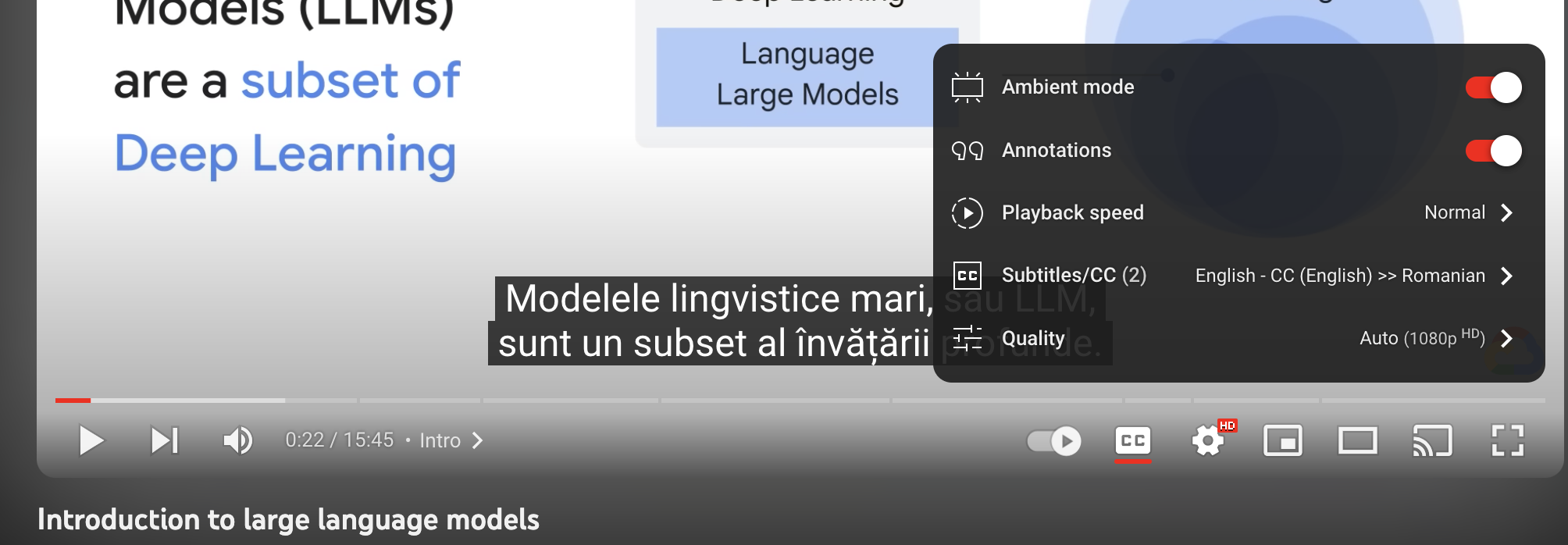Cursul interactiv
Alege din temele de mai jos (în limba engleză) una (aleatoriu). Folosește apoi ChatGPT sau Google Bard ca să o traduci și să o rezolvi.
1. Think about your interactions with AI models in your daily life. Consider the prompts you give and the responses you receive. Are there instances where the AI's response was not what you expected? Could a different prompt have led to a better response? Jot down your thoughts, and we'll discuss more in our next lesson.
2. Identify an AI application in your daily life or work where prompt engineering is crucial. Briefly describe how prompts are used in this application and why they are important.
3. Consider an AI model you've interacted with (like a chatbot or a virtual assistant). Reflect on the responses you received. Were they accurate and relevant? How might the factors we discussed today have influenced these responses?
4. Think of an AI interaction you've had recently. How well did the prompts used in that interaction align with the principles we discussed today? Write a brief analysis.
5. Identify an example of each prompt type from your interactions with AI models. Write a brief description of each example and explain why it fits the category.
6. Think of an interaction you've had with an AI model where the context and relevance of the prompts were well-handled. Write a brief analysis of this interaction, explaining how context and relevance were used effectively.
7. Choose an AI model you've interacted with and design a prompt using each of the techniques we discussed today. Write a brief analysis of how each technique might influence the AI model's response.
8. Consider an ambiguous prompt you've encountered in your interactions with AI models. How was the ambiguity handled? How could it have been handled better? Write a brief analysis.
9. Think of a complex task for which you might want to use an AI model. Design a series of prompts to guide the AI model through this task. Write a brief analysis of your prompt design process.
10. Choose a prompt you've used in an interaction with an AI model. Evaluate its effectiveness using the methods we discussed today. Write a brief analysis of your findings.
11. Choose a prompt you've used in an interaction with an AI model. Apply the iterative process of prompt refinement to this prompt. Write a brief analysis of your process and your changes to the prompt.
12. Think of an AI application you use regularly. How could the prompts in this application be refined to improve the AI's responses? Write a brief proposal for improving the prompts.
13. Reflect on an interaction you've had with an AI model. Did you notice any bias in the AI's responses? How could the prompts be refined to mitigate this bias? Write a brief analysis.
14. Review the prompts you've designed previously. Do they align with the ethical guidelines we discussed today? Write a brief analysis.
15. Consider a situation where an AI model might generate a harmful or unwanted response. How could you refine the prompt to mitigate this risk? Write a brief proposal.
16. Think of a multi-modal AI task, such as generating a text description of an image or transcribing speech from an audio file. Design a prompt for this task and write a brief analysis of your design process.
17. Think of an interactive AI task, such as a conversation with a chatbot or a game played against an AI opponent. Design a series of prompts for this task and write a brief analysis of your design process.
18. Reflect on what you've learned in this course. How do you see the skills and concepts we've discussed apply to future developments in AI and prompt engineering? Write a brief reflection.
19. Think of an application for a multimodal model. What types of prompts might you use for this application? Write a brief proposal.
20. Think of an application for a multilingual model. What types of prompts might you use for this application? Write a brief proposal.
21. Reflect on the future directions we discussed today. How might they impact your work or life? Write a brief reflection.
22. Think of an application for a multimodal AI model. Design a prompt for this model that integrates multiple types of data. Write a brief analysis of your prompt design process.
23. Choose a language other than English and design a prompt for a multilingual AI model that works in both English and the chosen language. Write a brief analysis of your prompt design process.
Folosește-te de ChatGPT sau Google Bard pentru a traduce și rezolva următoarele întrebări referitoare la Prompt Engineering.
- What is prompt engineering?
- Why is prompt engineering important?
- What are the key components of prompt engineering?
- List three applications of prompt engineering.
- How does prompt engineering impact user experience?
- What are AI models?
- How do AI models generate responses to prompts?
- What are three factors that influence the responses of AI models?
- What is prompt design?
- What are the five principles of prompt design?
- Why is iterative refinement important in prompt design?
- What are open-ended prompts? Give an example.
- What are closed-ended prompts? Give an example.
- What are instructional prompts? Give an example.
- What are exploratory prompts? Give an example.
- What is context in prompts? Why is it important?
- What is relevance in prompts? Why is it important?
- How can context and relevance enhance the effectiveness of prompts?
- What are four techniques for eliciting specific responses from AI models?
- How does providing context in a prompt help elicit a specific response?
- What is prompt sequencing, and when might it be useful?
- What is ambiguity in prompts?
- Why is ambiguity a problem in prompt engineering?
- What are three techniques for handling ambiguity in prompts?
- What are complex tasks in the context of AI?
- What are some challenges in designing prompts for complex tasks?
- What are three techniques for designing prompts for complex tasks?
- Why is it important to evaluate prompt effectiveness?
- What are four methods for evaluating prompt effectiveness?
- How can A/B testing be used to evaluate and refine prompts?
- What is prompt refinement, and why is it important?
- What are the steps in the iterative process of prompt refinement?
- How can prompt refinement improve the quality of AI responses?
- What is bias in AI responses?
- How can prompt engineering help mitigate bias?
- What are three ethical guidelines for prompt design?
- Why is it important to respect user privacy in prompt design?
- How can prompts be designed to promote fairness and inclusivity?
- What are harmful or unwanted responses?
- How can prompt engineering help mitigate harmful or unwanted responses?
- What role do moderation tools play in mitigating harmful or unwanted responses?
- What is multi-modal prompt design?
- What are some challenges in multi-modal prompt design?
- What are three strategies for designing effective multi-modal prompts?
- What are interactive tasks?
- What are some challenges in designing prompts for interactive tasks?
- What are three strategies for designing prompts for interactive tasks?
- What are multimodal models?
- What is prompt engineering for multimodal models?
- What are some challenges and opportunities in prompt engineering for multimodal models?
- What are multilingual AI models?
- What are some challenges in prompt engineering for multilingual models?
- What are two techniques for prompt engineering for multilingual models?

